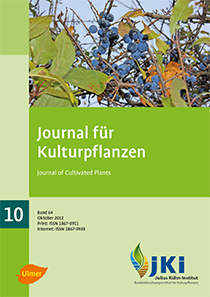Perspectives and limitations of weed control in organic lentils (<em>Lens culinaris</em>)
DOI:
https://doi.org/10.5073/JfK.2012.10.01Keywords:
Mixed cropping, competition, false seedbed techniques, sowing depth, hoe, harrow, crop density, sowing timeAbstract
The cultivation of lentils (Lens culinaris) is currently a niche production in Germany, because agronomic knowledge about weed control has been lost during the last decades, and because the traditional knowledge was not adapted to modern cropping conditions.
A compilation of strategies for weed control from Central European history and from studies of other countries with modern lentil cropping systems should reveal options to develop concepts for weed control in Central European organic farming. Indirect strategies for weed control are discussed in the current paper, namely crop rotation, clean seed, varieties, primary tillage, sowing date, crop density and companion crops for lentils grown in mixed cropping systems. Considering the crop rotation, root and tuber crops such as potatoes or beet roots seem suitable as preceding crops because they provide comparatively weed free fields for following lentils. The adoption of this crop sequence needs to revise traditional thinking, in particular the assumption that lentils grow best only on marginal lands. The increase of crop densities seems useful to improve the competition ability with weeds by high biomass production and land cover. In mixed cropping systems, an increased share of companion crops (usually cereals) can suppress weeds without relevant decrease in lentil yield. Direct measures discussed in the paper are mechanical and thermal measures. Flame weeding and solarisation do not seem useful for Central Europe because of high costs and an unsuitable climate. Hand-weeding or hand-hoeing are not realistic in industrialized countries with high labor costs, though these measures turned out to be quite effective in field trials. Three promising strategies were revealed in the study for direct mechanical weed control: 1. sowing in late spring, with preceding false seedbed techniques to stimulate weed emergence; 2. deep sowing of lentils to delay emergence, and “blind” harrowing before the seeds have emerged to destroy weeds; 3. increased row spacing, and hoeing or harrowing (curry combing). In case hoes or harrows are used, possible harvesting problems have to be considered resulting from stones at the soil surface. Plenty of options were shown to control weeds in lentils effectively without the use of herbicides. From this set of management strategies, growers can easily select suitable methods according to their specific farm conditions. The strategies can also be used for other crops in organic farming.
Downloads
Published
Issue
Section
License
The content of the journal is licensed under the Creative Commons Attribution 4.0 License. Any user is free to share and adapt (remix, transform, build upon) the content as long as the original publication is attributed (authors, title, year, journal, issue, pages).
The copyright of the published work remains with the authors. The authors grant the Journal of Cultivated Plants, the Julius Kühn-Institut and the OpenAgrar repository the non-exclusive right to distribute and exploit the work.







